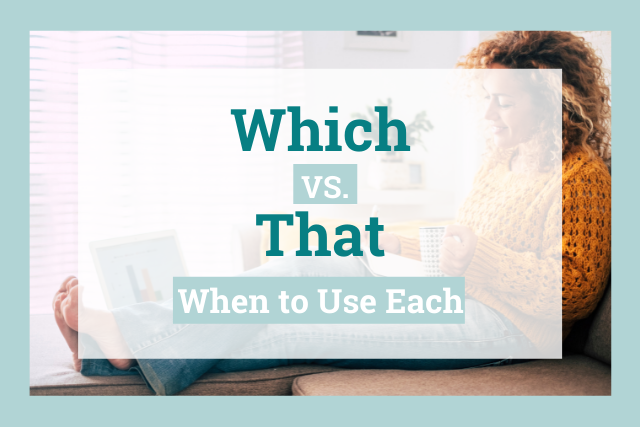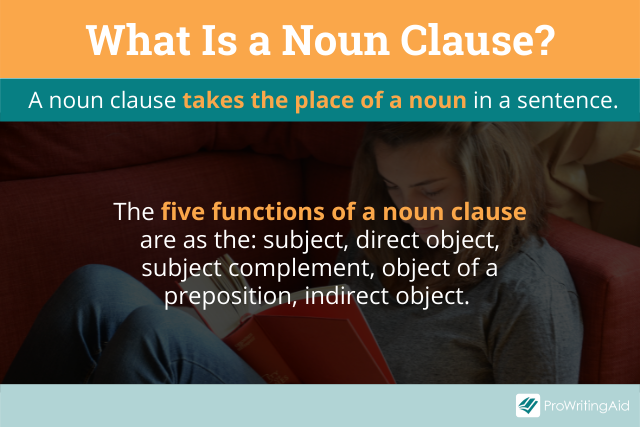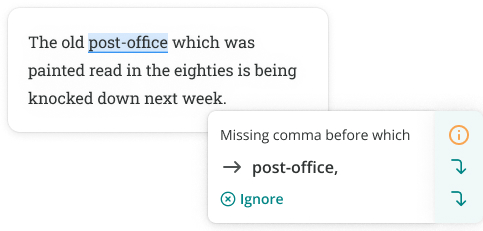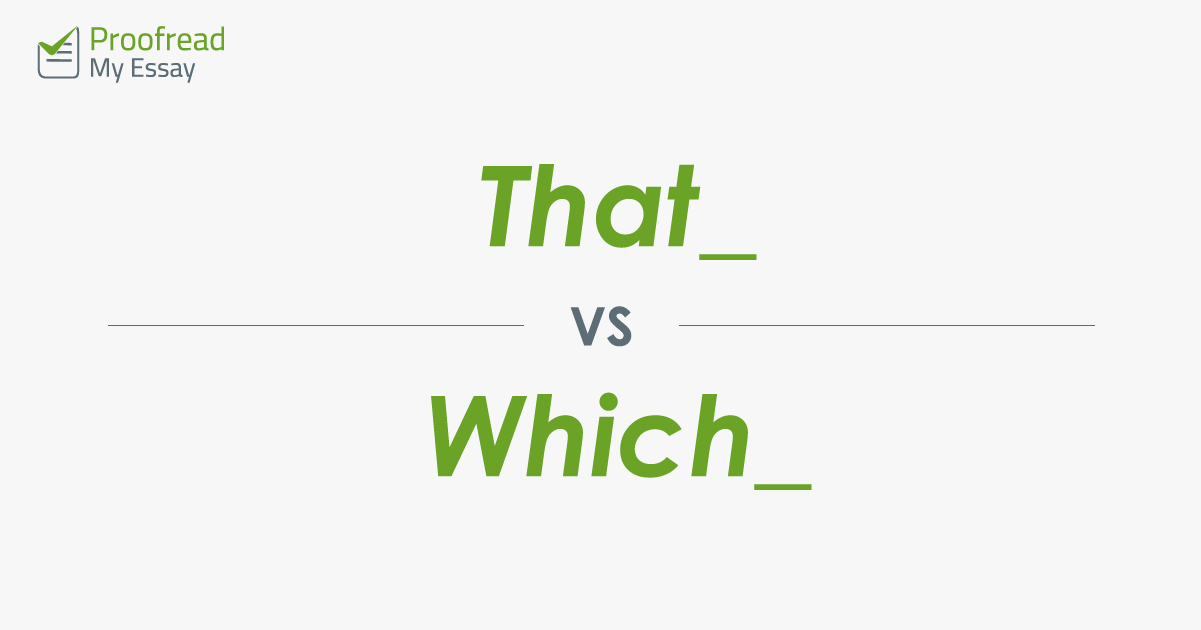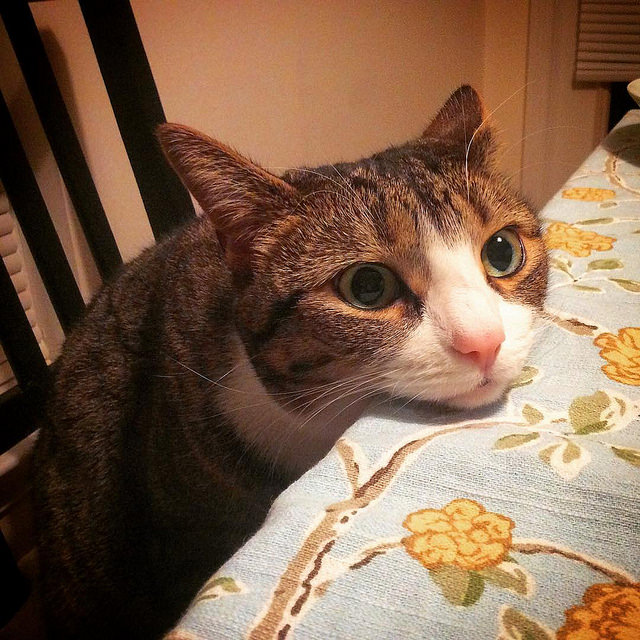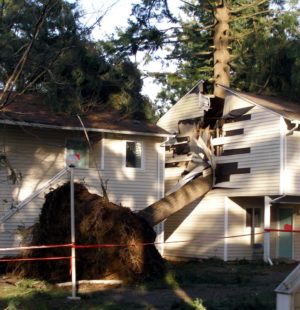Many people use “which” and “that” interchangeably but the two words are not synonymous.
“Which” and “that” both refer to something previously mentioned when introducing another clause.
The difference between them is “which” introduces a non-essential clause and “that” introduces an essential one.
Read on to learn how to identify clauses and subsequently use the right word every single time.
The Trick for Remembering Which vs. That
There’s a simple trick to remember the difference:
If your sentence has a clause but does not need it, use “which”; if the sentence does need the clause, use “that.”
Before we look at when to use “that” or “which,” let’s quickly discuss what a clause is.
What Is a Clause?
A clause is a group of words that contains a subject and a predicate.
A subject is the thing that the clause is about. A predicate contains the verb and says something about the subject.
Examples of clauses are:
- When I was running (dependent)
- That went missing yesterday (dependent/adjective)
- I ate pasta and apple crumble (independent)
There are two main types of clauses: independent and dependent.
Dependent clauses can be split further into noun and adjective clauses.
Within these categories, there are two types of noun clauses, restrictive and non-restrictive, which are essential to understand the difference between “which” and “that.”
Which vs. That: Let Us Explain
The clause that comes after the word “which” or “that” is the determining factor in deciding which one to use.
If the clause is essential to the meaning of the sentence, you use “that.”
If you could drop the clause and leave the meaning of the sentence intact, use “which.”
For example:
- The school that burned down last week is still smoking.
- The school, which burned down last week, is next to Mila’s restaurant.
In the first sentence, the clause “that burned down last week” is essential because it identifies the school that is still smoking. Without the clause, we could refer to any school. With an essential clause, use the word “that.”
In the second sentence, the clause “which burned down last week” is non-essential because it is unnecessary to identify the school. Without it, the sentence would still make sense. With a non-essential clause, use the word “which.”
How to Use Commas with Which vs. That
“Which” and “that” are relative pronouns that begin adjective clauses. Both tell us a little more about the noun they follow.
The clauses that start with “that” are called restrictive because they ONLY tell us about the noun being discussed and are not surrounded by commas.
The “which” clause is non-essential or non-restrictive and is always set off from the rest of the sentence with commas.
Examples of When to Use Which vs. That
- The old schoolhouse, which is one of my favorite historical sites to visit, is in dire need of renovation.
In this case, you could drop the clause “which is one of my favorite historical sites to visit” and the sentence would still make sense.
On the flip side, try this example:
- The type of antibiotic that the doctor prescribed made me nauseous.
Clearly, it’s not just any antibiotic, but the one the doctor prescribed that made you sick to your stomach. The sentence without the clause doesn’t make sense.
Start Editing Like a Pro
Once you’ve checked your use of “which” and “that,” use ProWritingAid to make sure the rest of your sentence is stylistically and grammatically correct, too.
Our Realtime report lets you see and fix grammar, style, and spelling issues quickly. If you would like to know more about a suggestion, just click on the orange “i.”
You’ll see articles and videos to help you learn as you edit.
Extended Example of Which vs. That
In some sentences, both “which” and “that” are grammatically correct but provide slightly different meanings, like in the example below.
- Our home, which has four bedrooms, is located in the Caribbean.
- Our home that has four bedrooms is located in the Caribbean.
The first sentence discusses the location of your only home and it just so happens to have four bedrooms. Lucky you, it’s in the Caribbean.
The second sentence points out that the home you own with four bedrooms is located in the Caribbean, which means you have more than one home. “That has four bedrooms” is how you distinguish between your many homes.
Which vs. That: Quiz
Now that you know how to use “which” and “that,” are you ready for a quick test? I have omitted all commas because otherwise it would be too easy.
1) The lion __ I saw at the zoo scared me.
2) My summer chemistry project __ I handed in yesterday got an A!
3) My dress __ I wore last week has a hole in it.
4) My boat __ is at the summer house in Devon was repainted last week.
5) Jupiter __ is next to Saturn is the largest planet in our solar system.
Answers: 1) either 2) which 3) that 4) either 5) which
A big congratulations if you got all of them right because I was a little mean with sentences 1 and 4. Both the words “that” and “which” are grammatically correct depending on whether you have seen lions in the wild and how many boats the speaker has.
In sentence 4, if they have multiple boats then “that” is correct because it is necessary to identify which boat they are discussing. If they only have one boat then “which” is correct because we would already know where the boat is located and therefore the clause is not essential.
As a writer (me) once said:
“That which confuses you can only make you a better writer.”
Do you have any sentences like this that use both “which” and “that”? Share them in the comments.
Take your writing to the next level:
20 Editing Tips From Professional Writers
Whether you are writing a novel, essay, article or email, good writing is an essential part of communicating your ideas.
This guide contains the 20 most important writing tips and techniques from a wide range of professional writers.

To understand when to use that and when to use which, it’s important to keep in mind the difference between restrictive and nonrestrictive clauses. In formal American English, that is used in restrictive clauses, and which is used in nonrestrictive clauses. Not sure what that means? Let’s find out!
How to use that vs. which
A restrictive clause contains information that limits the meaning of a noun and is necessary in a sentence. For example, in the sentence Any book that you like must be good, the clause that you like is restrictive because it identifies which book: the one that you like.
Take a look at the meaning of the sentence if the clause is removed: any book must be good. Without the clause, the meaning of the sentence is altered, and therefore, the clause is needed.
Note that in restrictive clauses, sometimes that can be omitted. Any book you like must be good is also often used, especially in informal settings.
Examples sentences using that
In the following sentences, the precise meaning is altered if each restrictive clause is removed:
- The song that you performed right before intermission is my favorite.
- I think I finally caught a glimpse of the bird that is building a nest in the window.
- Do you remember the name of the book that Carla recommended to us?
These grammar rules can really have a dizzying effect … or is it “affect”? Find out the difference, here.
A nonrestrictive clause, on the other hand, is used to supply additional information that is not essential to understanding the main point of the sentence. Consider this example: The book, which I found at a dusty used bookstore, was a real page-turner. The clause which I found at a dusty used bookstore is nonrestrictive because it adds extra information, almost like an aside. You could delete the details about the bookstore, and the sentence would still make sense. In this example, which is preceded by a comma; nonrestrictive clauses tend to follow punctuation like a comma, a dash, or parenthesis. Which is only used in restrictive clauses if it is preceded by a preposition.
Example sentences using which
In these examples, the information provided by each nonrestrictive clause is not essential.
- This sandwich, which has my favorite pickles, is delicious!
- Juan’s birthday party, which was going to be held at the park, has been postponed.
- These pairs of pants, which no longer fit me, should be given away.
How to remember whether to use that or which
Luckily there’s an easy way to remember whether to use that or which. If the relative clause contains information that is not essential to the meaning of the sentence, and is also preceded by a comma, a dash, or parenthesis, it’s probably nonrestrictive, so use which. If not, odds are it’s restrictive, so use that.
However, the above distinction is a rule of formal American English, and is not as strictly observed in British English or in informal English of any type.
Download Article
Download Article
It can be hard to know when to use “which” and when to use “that” in a sentence, even if you are a native English speaker. Knowing the difference between a restrictive and non-restrictive clause and when and how to use them can help you learn how to use “which” and “that” correctly.
-
1
Determine what a restrictive clause is. The key to knowing if you need to use “which” or “that” in a sentence is deciding if you need to create a restrictive or non-restrictive clause.
- A restrictive clause is one that sets limits on the subject of the sentence. A restrictive clause also contributes to the meaning of the sentence – the sentence won’t make sense without the restrictive clause.
- For example, the sentence “I like flowers that are purple” has a restrictive clause in it and removing it would change the meaning of the sentence. “That are purple” is the restrictive clause, because without it you would just be telling people that you like flowers in general.[1]
-
2
Determine what a non-restrictive clause is. A non-restrictive clause adds information to the sentence, but removing it doesn’t change the meaning of the sentence. These are usually separated by commas before and after the clause. They may also be distinguished by dashes or parentheses.
- For example, the sentence, “The car, which is red, was totaled in the accident,” has a non-restrictive clause in it because “which is red” can be removed without changing the sentence’s meaning. The car will still be totaled, whether we know its color or not. “Which is red” is the non-restrictive clause.[2]
Advertisement
- For example, the sentence, “The car, which is red, was totaled in the accident,” has a non-restrictive clause in it because “which is red” can be removed without changing the sentence’s meaning. The car will still be totaled, whether we know its color or not. “Which is red” is the non-restrictive clause.[2]
-
3
Determine if you’re using a restrictive or non-restrictive clause. When you’re trying to figure out if you’re using a restrictive or non-restrictive clause, ask yourself if the clause changes the meaning of the sentence or if it just adds information to it.
- If taking out the clause changes the meaning of the sentence, you’re using a restrictive clause. In the sentence «Jimmy likes apples that are red» taking out «that are red» changes the meaning of the sentence; we might think Jimmy likes all apples and not just the red ones. «That are red» is, therefore, a restrictive clause.
- If taking out the clause doesn’t change the meaning of the sentence, you’re using a non-restrictive clause.[3]
In the sentence «Jimmy thinks apples, which grow on trees in his yard, are the best fruit,» taking out «which grow on trees in his yard» doesn’t change the meaning of the sentence. We still learn that apples are Jimmy’s favorite fruit, and therefore «which grow on trees in his yard» is a non-restrictive clause.
Advertisement
-
1
Use “that” for restrictive clauses. If you determine that omitting the clause changes the meaning of the sentence, you need to use “that” in your sentence.[4]
- For example, in the sentence “I like dogs that are brown,” the clause “that are brown” is crucial to understanding the sentence; it limits what type of dogs you like.
-
2
Use “which” for non-restrictive clauses. If omitting the clause only removes additional information from the sentence, you need to use “which” in your sentence.
- For example, in the sentence “I took the firetruck, which is my niece’s favorite toy, to be fixed,” the clause “which is my niece’s favorite toy” only adds information to the sentence. You’re taking the firetruck to be fixed – the fact that the truck is your niece’s favorite doesn’t change the meaning of the sentence.[5]
- For example, in the sentence “I took the firetruck, which is my niece’s favorite toy, to be fixed,” the clause “which is my niece’s favorite toy” only adds information to the sentence. You’re taking the firetruck to be fixed – the fact that the truck is your niece’s favorite doesn’t change the meaning of the sentence.[5]
-
3
Determine where you should place commas. If you’re creating a non-restrictive clause and therefore using “which” in your sentence, the clause should usually be surrounded by commas. In some cases, though, you may also use dashes or parentheses to separate a non-restrictive clause.
- For example, “I love lobster, which is expensive, because it reminds me of growing up by the ocean,” would still have the same meaning without “which is expensive.” Therefore, «which is expensive» is the phrase you should surround with commas.
- If you know you have a non-restrictive clause and need to use “which,” but don’t know where to put the commas, test it. Your sentence should still make sense if you take out the words surrounded by commas.[6]
Advertisement
Add New Question
-
Question
How is «which» used in a question?
«Which» is used in a question when you are referring choices or options. Some examples would be «Which flower do you like?» «Which song do you want to play?» «Which store are we going to?»
-
Question
How do I use «should» and «must» correctly?
«Should» is a suggestion; «must» is an insistence, usually used when something is imperative.
-
Question
«I was sorry that I could not to go to class.» Is this sentence correct?
Almost. «…that I could not go to class.»
See more answers
Ask a Question
200 characters left
Include your email address to get a message when this question is answered.
Submit
Advertisement
Video
References
About This Article
Article SummaryX
To use “that” and “which” correctly, determine if the clause in question would change the meaning of the sentence if it were removed. If it does change the meaning of the sentence, use “that.” For example, in the sentence, “I like flowers that are red,” you’d use “that” because if you removed the phrase, “that are red,” the meaning of the sentence would change. Alternatively, if the phrase is just adding information to the sentence, as in, “That car, which is red, is mine,” you’d use “which” because removing the phrase, “which is red,” wouldn’t change the meaning. For tips on how to place commas around these types of phrases, read on!
Did this summary help you?
Thanks to all authors for creating a page that has been read 120,589 times.
Reader Success Stories
-
«I’ve wondered about which and that usage, and your example with pictures fits perfectly for remembering the…» more
Did this article help you?
Last week’s grammar tip focused on the rules for using who vs. that. This week, we will learn the rules to guide us on when to use that vs. which.
NOTE: We feel that maintaining the distinction between that and which in essential and nonessential phrases and clauses is useful, even though the principle is sometimes disregarded by experienced writers.
Rule 1: That may refer to people, animals, groups, or things. (As mentioned last week, who is preferred when referring to people.)
Rule 2: Which refers to animals, groups, or things.
Since that and which may each refer to animals, groups, or things, how do we know when to use that and when to use which?
Rule 3: That introduces essential clauses while which introduces nonessential clauses.
Example: I do not trust editorials that claim racial differences in intelligence.
We would not know which editorials were being discussed without the that clause.
Example: The editorial claiming racial differences in intelligence, which appeared in the Sunday newspaper, upset me.
The editorial is already identified. Therefore, which begins a nonessential clause.
NOTE: Essential clauses do not have commas surrounding them, while nonessential clauses are surrounded by commas.
Example: Chess is a game that requires intense concentration.
The second part of the sentence is essential for conveying the meaning of the sentence.
Rule 4: If this, that, these, or those has already introduced an essential clause, you may use which to introduce the next clause, whether it is essential or nonessential.
Example: Those responses to the questions, which were not well thought out, eliminated him from further job consideration.
Rule 5: Try not to use that twice in a row in a sentence.
Example: That is a problem that can’t be solved without a calculator.
This sentence would be better written as: That is a problem which can’t be solved without a calculator.
The best way to write the sentence would be: That problem can’t be solved without a calculator.
Example: That is a promise that cannot be broken.
Again, the above sentence could be rewritten as: That is a promise which cannot be broken.
The best way to rewrite it would be: That promise cannot be broken.
Rule 6: Whenever you have more than one that or which in a sentence, see if you can rewrite it in a way that removes at least one that or which.
Pop Quiz
Choose whether that or which is correct for each sentence. Then determine whether the sentence should contain commas. If so, place the commas in the correct location in the sentence.
1. Hannah is on the team that/which won the county softball championship.
2. The Fairview Hawks softball team that/which my daughter played on won the county softball championship.
3. The Golden Gate Bridge that/which was completed in 1937 is considered by many to be the most beautiful bridge in the world.
4. The bridge that/which connects the city of San Francisco with Marin County was completed in 1937.
5. That rooster that/which crows every morning at dawn is going to drive me crazy.
6. That is a point that/which is worth considering.
Quiz Answers
1. Hannah is on the team that won the county softball championship.
2. The Fairview Hawks softball team, which my daughter played on, won the county softball championship.
3. The Golden Gate Bridge, which was completed in 1937, is considered by many to be the most beautiful bridge in the world.
4. The bridge that connects the city of San Francisco with Marin County was completed in 1937.
5. That rooster, which crows every morning at dawn, is going to drive me crazy.
6. That is a point which is worth considering. (“That is a point that is worth considering” is also acceptable, but the best answer is either “That point is worth considering.” OR “That is a point worth considering.”)
Advertisement
If the article or the existing discussions do not address a thought or question you have on the subject, please use the «Comment» box at the bottom of this page.
For two such common words, ‘that’ and ‘which’ cause a lot of headaches. This is probably because UK and American English differ slightly in terms of how they’re used. But what are these differences? And how should you use ‘that’ and ‘which’ in your written work? Let’s take a look.
Relative Clauses
‘That’ and ‘which’ are both relative pronouns. This means they are used to introduce information in a sentence that tells us more about a noun.
For example, if we say ‘the cat is outside’, nothing in the sentence specifies which cat we mean. It could be any cat.
But if we say ‘the cat that stole your lunch is outside’, the relative clause ‘that stole your lunch’ gives us an idea about which cat we’ve spotted.
(Photo: brownpau/flickr)
To explain the difference between ‘that’ and ‘which’, we need to look at restrictive and non-restrictive relative clauses.
Restrictive and Non-Restrictive Relative Clauses
A restrictive relative clause restricts the meaning of what we’re saying. For example, the restrictive clause in this sentence is ‘that I built’:
The house that I built survived the storm.
In this case, ‘that I built’ is restrictive because it specifies the particular house we’re talking about. This implies that we’re using this extra information to pick one house out of several possible houses.
(Photo: Ryan Kitko/wikimedia)
A non-restrictive clause, on the other hand, simply provides more information about the thing we’re talking about rather than identifying it:
The house, which I built, survived the storm.
In this case, the relative clause is set apart with commas because it isn’t essential to the sentence. We thus use non-restrictive clauses if there is no doubt about what we’re discussing but want to provide extra detail.
In summary, we can think of these different clause types as follows:
- Restrictive clauses identify the thing we are talking about, so they cannot be removed from a sentence without changing its meaning.
- Non-restrictive clauses provide extra, non-essential detail about the thing we’re talking about. As such, we set this information apart from the main sentence with a comma or pair of commas.
Word Choice: That or Which?
You may have noticed that we use ‘that’ for a restrictive clause and ‘which’ for a non-restrictive clause in the examples above. This is the standard usage in American English, so you will see restrictive clauses written like this a lot.
In British English, however, ‘that’ and ‘which’ can both be used for restrictive clauses, allowing for a bit more flexibility. But in both the US and the UK, non-restrictive clauses are only written with ‘which’.
If you want to avoid confusion, use ‘that’ for restrictive clauses and ‘which’ for non-restrictive clauses. But this is a matter of style for restrictive clauses, especially in the UK. Keep the following in mind if you’re unsure:
|
That or Which? |
Example Sentence |
British English |
American English |
|
That (Restrictive) |
The house that I built survived. |
✓ |
✓ |
|
That (Non-Restrictive) |
The house, that I built, survived. |
✗ |
✗ |
|
Which (Restrictive) |
The house which I built survived. |
✓ |
✗ |
|
Which (Non-Restrictive) |
The house, which I built, survived. |
✓ |
✓ |
Find this useful?
Subscribe to our newsletter and get writing tips from our editors straight to your inbox.

